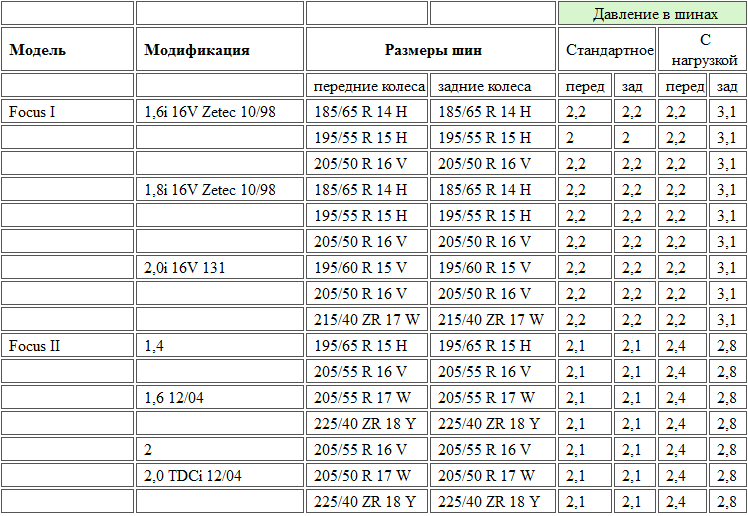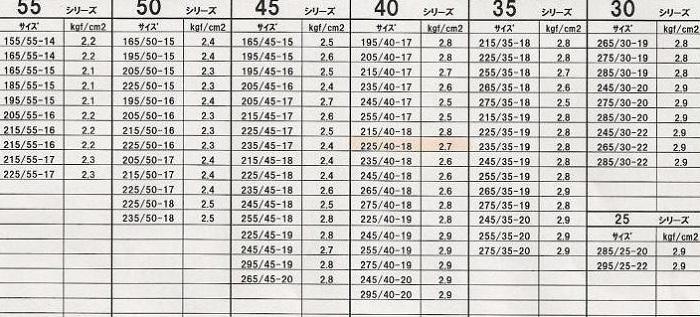
Pressure table for tire sizes
Content
When inflating the tires of any vehicle, it is always necessary to maintain the pressure set by the manufacturer, since failure to comply with this important rule adversely affects the operation of the tires, and also affects road safety. What should be the correct pressure in the tires of the car (table). Let's talk about the dependence of the degree of pumping on the weather, road conditions and test methods.
What happens if tire pressure is not observed
Most front-wheel drive vehicles (both domestic and foreign) can be equipped with wheels with a radius of R13 - R16. However, the basic equipment almost always includes R13 and R14 wheels. The value of the optimal pressure in the tires of the car is selected based on their mass at full load. In this case, it is necessary to take into account the weather and road conditions in which the vehicle is operated.
If the wheels are inflated incorrectly
- Driving the car will become difficult, you will have to make more efforts to turn the steering wheel;
- tread wear will increase;
- increased fuel consumption when driving with flat tires;
- the car will skid more often, which is especially dangerous when driving on ice or on a wet track;
- there will be a decrease in the dynamic power of the vehicle due to the constant increase in the force of resistance to movement.

If the wheels are over-pumped
- Increased wear on chassis parts. At the same time, all the pits and potholes on the road are felt while driving. Loss of driving comfort;
- as the pressure in the tires of the car becomes excessive, as a result of this, the contact area of the tire tread with the road surface decreases. Due to this, the braking distance is significantly increased and the safety of the vehicle operation is reduced;
- the tread wears out faster, which significantly reduces the operational period of automobile tires;
- Excessive pressure in the tires when they come into contact with an obstacle at high speed can cause a hernia, and even breakage of the tire. This situation is extremely dangerous and can have tragic consequences.
Most owners of cars with R13 and R14 wheels (the most common with spokes) are interested in: what should be the optimal pressure in the car's tires? According to the manufacturer's recommendation, tires of the thirteenth radius should be inflated up to 1,9 kgf / cm2, and wheels of size R14 - up to 2,0 kgf / cm2. These parameters apply to both front and rear wheels.
Dependence of tire pressure on climatic and road conditions
In principle, both summer and winter it is necessary to maintain the same tire pressure. However, it is not recommended to lightly inflate tires in winter. This is necessary for:
- Increases vehicle stability on slippery roads. In winter, driving becomes more convenient and comfortable with slightly flat tires.
- Road safety is improved as the stopping distance of the vehicle is significantly reduced.
- Inflated winter tires soften the suspension, making bad road conditions less noticeable. Increased driving comfort.
You also need to know that with a sharp change in temperature (for example, after the car left the hot box in the cold), due to some physical properties, a decrease in tire pressure occurs.
Therefore, before leaving the garage in winter, it is necessary to check the pressure in the tires and, if necessary, inflate them. Do not forget about the constant monitoring of pressure, especially during temperature changes and out of season.
The recommended tire pressure R13 with the advent of summer is 1,9 atm. This value is calculated based on the fact that the car will be half loaded (driver and one or two passengers). When the car is fully loaded, the pressure of the front wheelset should be increased to 2,0-2,1 atm, and the rear - up to 2,3-2,4 atm. The spare wheel must be inflated to 2,3 atm.
Unfortunately, the road surface is not ideal, so most motorists prefer not to inflate their tires a little. Because thanks to this, all the bumps and bumps on the road are not so strongly felt when driving. Often in summer, tire pressure decreases by 5-10%, and with the advent of winter, this figure slightly increases and amounts to 10-15%. When driving on smooth roads, it is best to maintain the tire pressure recommended by the manufacturer.
Taking into account all factors, a tire pressure table is compiled.
| Disk size and radius | Tire pressure, kgf / cm2 |
| 175/70 P13 | 1,9 |
| 175 / 65R13 | 1,9 |
| 175/65 P14 | 2.0 |
| 185 / 60R14 | 2.0 |

What should be the optimal pressure for larger wheels
Despite the fact that most domestic and foreign cars have wheels with a maximum radius of R14, most owners still install wheels with a larger radius (R15 and R16) to improve the appearance of their vehicle and improve some of its characteristics. Therefore, it is necessary to know what is the optimal pressure for tires of this size?
Here, too, it all depends on the degree of workload of the machine. At half load, the tire pressure threshold should not exceed 2,0 kgf / cm2, at full load this value is already 2,2 kgf / cm2. If a large amount of heavy luggage is carried in the trunk, the pressure in the rear wheelset must be increased by another 0,2 kgf / cm2. As you can see, the pressure in the tires of the fourteenth spoke is approximately equal to the pressure in R15 and R16.
How to measure pressure: the correct sequence
Unfortunately, even the most experienced drivers completely ignore the procedure for checking car tire pressure, considering this procedure to be absolutely useless. Tire pressure is checked using a pressure gauge, which can be built into the pump or a separate element. Do not forget that the error of any pressure gauge is usually 0,2 kgf / cm2.
Pressure measurement sequence:
- You have to reset the pressure gauge.
- Unscrew the protective cap (if any) from the wheel nipple.
- Attach a pressure gauge to the nozzle and press lightly to purge air from the chamber.
- Wait until the instrument pointer stops.
This procedure should be done monthly if the vehicle is used regularly. The measurement must be taken before leaving, when the rubber has not yet warmed up. This is necessary to accurately determine the readings, since as the tires warm up, the air pressure inside them increases. Often this is due to dynamic driving with a constant change in speed and sudden braking. For this reason, it is ideal to take measurements before a trip, when the car's tires are still warm.
Whether or not to inflate tires with nitrogen
Recently, almost every tire change station has an expensive service for filling tires with nitrogen. Its popularity is due to several of the following opinions:
- Thanks to nitrogen, the pressure in the tires remains the same when they are heated.
- The service life of rubber increases (practically does not “age”, since nitrogen is much cleaner than air).
- Steel wheel rims do not corrode.
- The possibility of tire breakage is completely excluded, since nitrogen is a non-flammable gas.
However, these statements are just another marketing hype. After all, the nitrogen content in the air is about 80%, and it is unlikely to get better if the nitrogen content in tires increases to 10-15%.
At the same time, you should not spend extra money and pump up the wheels with expensive nitrogen, since there will be no additional benefit and harm from this procedure.
